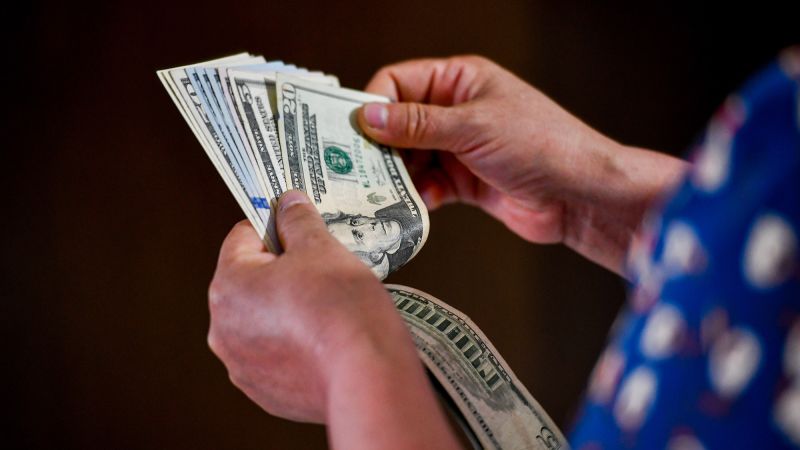A version of this story first appeared in CNN Business’ Before the Bell newsletter. Not a subscriber? You can sign up right here. You can listen to an audio version of the newsletter by clicking the same link.
New York
CNN
—
The greenback is strengthening again after a bumpy 2023, as Wall Street accepts that interest rate cuts are coming later than previously expected.
The US Dollar Index, which tracks the dollar against the British pound, euro, Swiss franc, Japanese yen, Canadian dollar and Swedish krona, is up 2.8% for the year as of Friday morning.
The US currency slid last November and ended the year lower against that basket of currencies as investors grew optimistic that the Federal Reserve would soon cut interest rates. But Fed Chair Jerome Powell said in January that interest rate cuts are unlikely to begin in March, as investors widely believed would happen.
Piping hot economic data in recent weeks has supported the notion that the Fed will keep rates higher for longer. The economy added an eye-popping 353,000 jobs in January, underscoring the labor market’s continued resilience despite elevated rates. The Consumer Price Index rose 3.4% annually in December, still above the central bank’s 2% target.
A stronger dollar is bad news for American companies that generate most of their revenue overseas, since it means fewer dollars for their bottom lines when other currencies, such as the euro, are converted into US dollars. But it also means that US companies and consumers could spend less for imported goods, and Americans’ purchasing power increases when traveling abroad.
Other countries’ monetary policy decisions also affect the greenback’s trajectory. The European Central Bank in January kept rates unchanged. But if ECB President Christine Lagarde so much as hints at a rate cut coming this summer, that could continue driving the dollar higher, says Quincy Krosby, chief global strategist at LPL Financial.
“All of a sudden the interest rate differential kicks in — if that is slower than the Fed or faster,” said Krosby.
Higher interest rates tend to garner more international capital to flow into a country, raising demand for the currency and thus its value.
The 10-year US Treasury yield has jumped back above 4% this year as investors recalibrate their rate expectations, providing another boost to the US currency.
Minneapolis Fed President Neel Kashkari said in an essay published Monday that rates might have found a higher neutral level after hovering near zero during the Covid pandemic.
“The implication of this is that, I believe, it gives the [Federal Open Market Committee] time to assess upcoming economic data before starting to lower the federal funds rate, with less risk that too-tight policy is going to derail the economic recovery,” wrote Kashkari.
Still, Todd Jones, chief investment officer at Gratus Capital, says he expects the dollar to trend lower eventually as the Fed gets closer to cutting rates. Investors widely expect that the Fed will begin cutting rates in May or June, according to the CME FedWatch Tool.
Provided that inflation continues to slide and the economy cools without crumbling, “that then puts you into just a pretty nice Goldilocks scenario [for markets],” said Jones.
Attacks on container vessels in the Red Sea have been wreaking havoc on one of the world’s most important trade routes for weeks, and shipping giant Maersk warned Thursday that the disruption could last as long as a year.
Iran-backed Houthi militants stepped up their attacks on ships in late November in retaliation for Israel’s war against Hamas.
The resulting delays and extra costs for shipping companies have fueled concerns that consumers still struggling after a prolonged spell of rampant inflation could be hit with fresh price rises, reports my colleague Anna Cooban.
There has been an “almost wholesale exodus” of larger container ships from the Red Sea and the adjoining Suez Canal, Richard Meade, editor-in-chief of shipping publication Lloyds List, told CNN. Those ships, which ferry everything from trainers to mobile phones from manufacturers in Asia to customers in Europe, have been taking longer routes to avoid the area.
That exodus is a big deal: The Suez Canal, which connects the Red Sea to the Mediterranean Sea, accounts for 10-15% of world trade, which includes oil exports, and for 30% of global container shipping volumes.
High commercial real estate vacancies are expected to create some stress for smaller banks, Treasury Secretary Janet Yellen said Thursday.
However, she said she does not see them as causing a systemic risk to the nation’s financial system, reports my colleague Alicia Wallace.
Appearing on the Hill as part of annual testimony before the Senate Banking Committee, Yellen told lawmakers Thursday the exposure of large banks is “quite low” but there may be smaller banks that are experiencing stress related to high office building vacancy rates, high interest rates and falling valuations.
“It’s obvious that there’s going to be stress and losses that are associated with this,” Yellen said.
“For some banks this will be a concern, but on balance, the system is well-capitalized,” she said, noting that, overall, the US financial system is sound.
